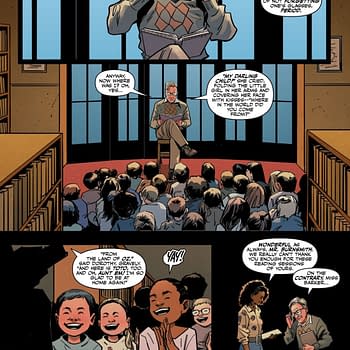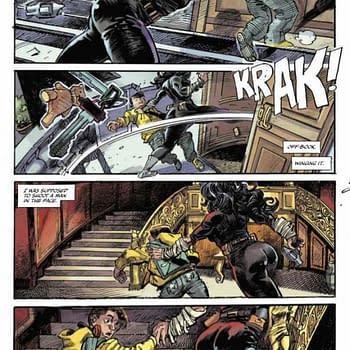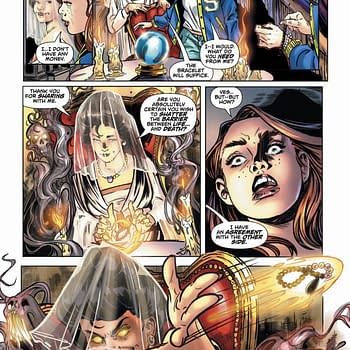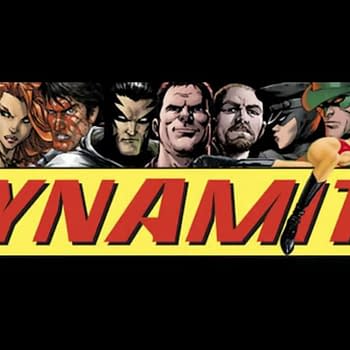Posted in: Comics | Tagged: Alan Moore, antony johnston, avatar press, courtyard, daredevil, fashion beast, malcolm mclaren, neonomicon, saga of the swamp thing, Sex Pistols, superman, swamp thing, v for vendetta, Watchmen, whatever happened to the man of tomorrow
Antony Johnston Provides Insight Into Long-Lost Alan Moore Project, Fashion Beast

Fashion Beast was written in 1985, during one of the most celebrated periods of Moore's career. He'd just begun his work on Saga of the Swamp Thing and V for Vendetta, introduced the character of John Constantine to the world, and was plotting such classic tales as Watchmen and Whatever Happened to the Man of Tomorrow? It's a historically relevant piece from a master in the genre.
The initial concept of Fashion Beast originated with McLaren, who approached Moore with a handful of different concepts intended for feature films. Moore picked the "Beauty of the Beast"-like tale and expanded it to a film script over 200 pages in length, every bit as dense and descriptive as his infamous comic scripts. Antony Johnston (Daredevil, The Courtyard) was hand-picked by Avatar Press to adapt the original screenplay into its comic book format, an experience which Johnston expands upon below.
What is the story of Fashion Beast about?
Well, there are two aspects to this; what *happens*, and what it's *about*. What happens is that Doll, a gender-bending nobody with aspirations to fame, gets plucked from obscurity by the world's foremost fashion designer — Celestine, a reclusive and obsessive hermit whose ugliness is as legendary as his capriciousness. This supposed dream opportunity becomes a nightmare as Doll sees the true industry behind the billboards and catwalks, and she finds unlikely allies in her desire to do something meaningful with her life. She also makes unlikely friends (and enemies), and that gets to what the story's actually *about*; life, death, the human need for social status, the cynics who will happily prey on that need, and the question of whether any of this matters. Is how we present ourselves to the world important? Does fashion have a role to play, in the face of global breakdown?

On the one hand, it's everything. The whole story centres around Celestine's salon, and most of the action takes place within its walls. But again, what the story's *about* — fame, celebrity culture, vanity, ego, sex, and death — is much more than just the industry. Fashion is the lens through which the story examines those themes.
How about music? Does music play a role in the telling of Fashion Beast? If not in the actual story itself, was there a soundtrack, perhaps, that played in the background as you wrote the script, setting your mood?
It does play a small but important role in the story. But to the best of my knowledge, no music or arrangement was ever made for the movie, even though several would certainly have been needed. So we've got around that in some interesting ways, including a significant contribution from Malcolm. My own soundtrack while scripting the book was generally a lot of dance and techno — some of it from the '80s, but by no means all, and it wasn't the only thing I listened to. I always have music playing while I'm working, but I don't rely on it to create a mood. I just like music a lot.
What would you say are elements of Fashion Beast that distinctly reflect the life / viewpoint of Malcolm McLaren?
Sadly, I never met Malcolm in person, so I really couldn't say. I suspect some of the examination of celebrity culture may have come from him, but I wouldn't like to speculate too much.
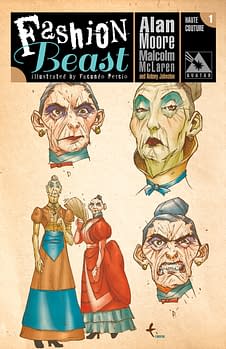
The same as I do with any adaptation; I read the original text, in this case the Fashion Beast screenplay, over and over again. Beyond that, I simply drew on my own experience and knowledge of fashion and its role in society and culture.
What does the Johnston/Moore collaborative process entail?
I spoke to Alan at length before starting the script, just to get a feel for how he saw the screenplay, ask him questions that came up while I was reading it, that sort of thing. After that, though, I simply put my head down and wrote the script. Alan always has final approval over everything, of course, from the script right through to final art. But by the time I wrote Fashion Beast, I'd already done several adaptations of his work, so I'd earned a certain amount of trust. It was pretty painless.
Is there a resonance between Fashion Beast and any particular Avatar Johnston/Moore project you've done in the past? A sense of deja vu?
I think the closest comparable book is The Hypothetical Lizard. It has the same otherworldly feel, and an exotic setting, but deals with deep emotional issues through a vulnerable main character. The story itself is unlike anything of Alan's I'd worked on before, though.
How different is the scriptwriting process (or final script) between projects that are wholly yours and those that you have adapted from other work?
The final script isn't very different at all. It's still a comic script, destined for an artist, who will interpret and draw it. The process, however, is very different, because of course the story is already set. When I'm writing original stories, much of the challenge is in figuring out how to get from A to B (or C, or D…) in the best and most interesting way. And I can change how that happens if I suddenly have a great idea, or think of a new twist. With an adaptation, I can't do that. The challenge instead is to figure out the best and most interesting way *to show how* the story gets from A to B (or C, or D…), without actually changing its core. So it's much more about craftsmanship, and doing justice to the original text.
As I understand it, the artist Facundo Percio does not speak English. Was there any consideration of that fact in writing the script?
Facundo does actually speak a small amount of English — certainly more than I speak Spanish! But yes, he has to get the scripts translated. As for whether that affected how I write the script, both yes and no. No, because we didn't actually know who would be drawing Fashion Beast when I was writing it; but yes, because I *never* assume English will be an artist's first language unless I know for sure. I learned that lesson a long time ago, and now I'm always very clear and precise in my scripts if I don't know who'll be drawing it at the time.
What are your thoughts on the work of Facundo Percio, on his previous work (Anna Mercury) and the final product that is Fashion Beast?
Facundo is a great artist, and a great storyteller. His character acting is superb, and his costume design/rendering second to none — which is of course very important for Fashion Beast. And you can see all that in Anna Mercury, which I really enjoyed.
Fashion Beast was originally designed as a screenplay. Did the cinematic vision of the original work influence how it was written for sequential art?
Yes. I used a lot of "widescreen" panels, where appropriate and possible, to replicate specific framing and shots that Alan intended. But I wasn't slavish about it; if a shot really didn't need to be widescreen, then it wasn't. It was just another tool in the box.
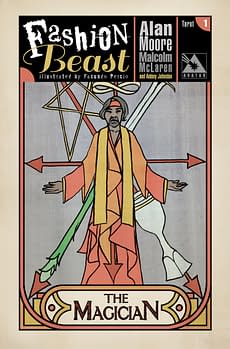
Celestine uses the Tarot heavily, both as a means of reflection and divination. He takes it seriously, and uses it to guide his life.
Do you have a favorite among the cast of characters? In a more global sense, can a writer afford to have sentimental feelings for a character?
Doll is a wonderfully complex and deep character, both very sympathetic and deeply flawed, so it's inevitable she'd be my favourite. But even though a writer will inevitably have characters they like, or enjoy writing more, you can't really let that influence the work. Once you start down that road, you're doing the audience a disservice.
As an aside… you wrote the comic script for the Lovecraftian tale The Courtyard based on a prose story by Alan Moore. What are your thoughts on Neonomicon, the sequel?
I thought it was interesting. Horrifying, disturbing, and unsettling, and I'm sure that's exactly what Alan would have hoped for. It's a book I'm glad I read, but that I have no desire to ever re-read… and again, I'm sure that's just the reaction Alan would want!
The cover images supplied with this article include, in order of appearance:
- Fashion Beast #1 Regular, Diamond Item Code: JUL120796
- Fashion Beast #2 Haute Couture Incentive, Diamond Item Code: AUG120843
- Fashion Beast #1 Haute Couture Incentive, Diamond Item Code: JUL120798
- Fashion Beast #1 Tarot Incentive, Diamond Item Code: JUL120799
- Fashion Beast #1 Wraparound, Diamond Item Code: JUL120797










